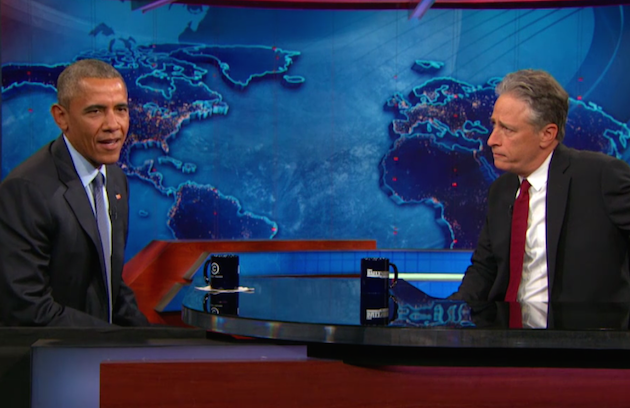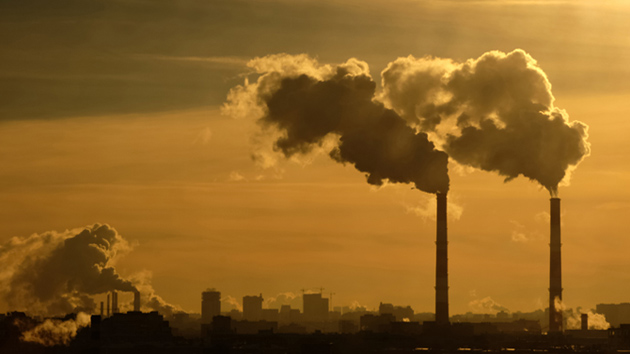President Barack Obama has been more vocal than any previous president about the need to combat climate change, and on Monday his administration released a package of rules that will likely be the most important—and most controversial—piece of his climate legacy.
“Climate change is not a problem for another generation,” Obama said in a video released early Sunday morning. The Clean Power Plan, as the rules finalized Monday are known, is “the biggest, most important step we’ve ever taken to combat climate change.”
Coal-fired power plants are the country’s biggest source of carbon dioxide emissions and the chief culprit driving global warming. They’re responsible for even more CO2 pollution than all the nation’s passenger vehicles. The new plan aims to slash those emissions by requiring every state to reduce the carbon “intensity” (that is, emissions per unit of energy produced) of its energy sector. By 2030, the plan is expected to slash the carbon footprint of the nation’s power sector by 32 percent below 2005 levels—a more rigorous target than the 30 percent reduction outlined in a draft version of the rules released last summer.
In the final draft, the administration has relaxed deadlines for meeting the new carbon targets—states will now have until 2018 to propose a carbon-cutting strategy and until 2022 to implement it—a serious concern for environmentalists who have stressed the necessity of immediate action to limit climate change. And although the targets might sound ambitious, they might not actually be too different from what many states would achieve without them, thanks to a boom in clean energy that is already underway. Moreover, many of the changes required by the rules will play out under Obama’s successor, leaving open the possibility that they could be undermined by a climate change-denying president.
Still, the significance of this official crackdown on the gas behind global warming is hard to overstate, said David Doniger, director of the clean air program at the Natural Resources Defense Council.
“The very fact that they’re regulating carbon pollution from power plants is a historic step, a huge step,” he said. “This is part of using the existing law to turn the US from doing nothing, to playing a leadership role to curb climate change.”
Draft versions of the rules, designed by the Environmental Protection Agency under the authority of the Clean Air Act, were first unveiled last summer. In the time since, as they underwent public review and revision, they’ve faced a backlash from Republican lawmakers in statehouses and in Congress, and from some major energy companies. The critics claim (probably without merit) that the rules will cause electric bills to skyrocket and blackouts to sweep the country. Earlier this year, Senate Majority Leader Mitch McConnell (R-Ky.) penned an op-ed calling on states to simply ignore the rules. Meanwhile, a major coal company teamed up with a dozen coal-reliant states to challenge the draft rules in federal court. The court declined to hear the challenge because the rules hadn’t yet been finalized.
But as of today the rules are final—and another round of legal challenges is inevitable, said Tomas Carbonell, director of regulatory policy at the Environmental Defense Fund.
“We are likely to see some of the opponents of the Clean Power Plan file a motion for a stay, which is an attempt to prevent it from going into effect,” he said. “We’ve heard grumblings, but nobody’s done anything yet.”
Before the final plan was even released, it drew fire from GOP presidential contender Sen. Marco Rubio (Fla.), who said it could cause electric bills to go up by “a couple of hundred dollars.” Meanwhile, Hillary Clinton came out in support of the plan, saying that if elected president she would work to protect the rules from “Republican doubters and defeatists.”
In an address Monday afternoon, Obama pushed back against criticism of the plan.
“We’ve heard these same stale arguments before,” he said, in reference to the chorus of complaints from Republican lawmakers and power companies that the plan will kill jobs and cost Americans money—the same package of concerns that is almost always raised about new environmental regulations. “Each time they were wrong.”
It’s not surprising that the coal industry has fiercely opposed to the rules. Under the plan, every state gets a customized target for reducing its carbon intensity. In most cases, meeting these targets will lower the state’s total carbon emissions; in some cases, economic growth in a state could offset some of the intensity gains and the state’s total emissions could stay flat or even go up. But the idea is that they’ll be lower than they would be otherwise.
The EPA came up with these targets based on its analysis of what each state can reasonably and cost-effectively achieve over the next couple decades. Although states will have a menu of options for reaching their individualized carbon targets—including building more renewable energy and improving energy efficiency standards—coal is likely to be a big loser. A lot of coal plants will shut down, switch to running on natural gas, or simply get used less as cleaner energy sources pick up more of the demand.
In some cases, state governments and power companies will have to spend money to make these changes happen. But according to a recent NRDC analysis, improving efficiency and relying more on high-performing clean energy will actually save power companies up to $9 billion by 2030. Those improvements could also reduce consumers’ electric bills, create jobs in the clean energy industry, and reduce the terrible and costly public health impacts of coal use. The rules are also a major piece of how the Obama administration plans to back up its promise to the upcoming United Nations climate summit in Paris to reduce total US carbon emissions 26 to 28 percent by 2025. And the changes not just being pushed by a cabal of environmentalists: Last week the sustainable business group Ceres released a letter supporting the rules from 365 major companies, including General Mills and Unilever.
At the same time, notwithstanding the Republican party’s “war on coal” rhetoric, it’s important to remember that this trend is well underway already, even before the Clean Power Plan comes into effect. The United States is using less coal than it has at anytime since the Industrial Revolution, thanks to cheap natural gas from fracking, the booming market for solar and other renewables, and regulations on other nasty pollutants from coal plants. As of last month, up to 40 percent of the US fleet of coal plants was scheduled to retire within a decade, according to the Sierra Club.
Because of those trends, the targets should be readily achievable. For example, an analysis from the Southern Environmental Law Center found that Virginia, North Carolina, and Tennessee, all of which are big coal consumers, are already on track to be at least 80 percent of the way to their proposed Clean Power Plan goals based on existing state-level plans and policies.
“This is not triggering a seismic shift in the energy industry,” said SELC senior attorney Frank Rambo.
Does that mean the rules are weak or pointless? Certainly they’re nowhere near what would be needed to completely de-carbonize the energy system, which is the ultimate goal for climate activists. But the NRDC’s Doniger said the rules are necessary to keep existing progress from backsliding.
“The power sector has been changing,” he said. “But just because the car is rolling doesn’t mean it will keeping rolling. You have to keep pushing it.”
The bigger question is what will happen to the rules if Americans elect a president who isn’t strongly committed to tackling climate change, or denies that it exists at all, which describes—to varying degrees—every Republican candidate in the race. It’s up to the EPA to enforce the rules, so a future president could take steps to dismantle them. But if President Trump wanted to change or eliminate the rules, he would have to kick off the same process of public review and revision that was required to put the rules in place.
“They can’t just unilaterally yank it,” Rambo said.
This post has been updated.















